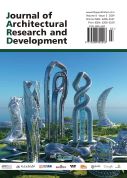Abstract
Temple of the Three Sus, which was first established during the Yuan Dynasty, features a natural, unrestrained, and classically elegant garden architectural style. This paper discusses the multiple characteristics and meanings of traditional architectural decorative patterns at Temple of the Three Sus from a semiotic perspective. First, it analyzes the denotative aspects of these patterns, including their stylistic forms, structural frameworks, and craftsmanship techniques. Second, the paper classifies the traditional architectural decorative patterns of the Temple of the Three Sus based on the types of sources of these patterns and interprets the implied meanings of each. Finally, the paper explores the application of these traditional decorative patterns in modern urban design, specifically in Meishan City, discussing the inheritance and innovation of these patterns in contemporary urban design and emphasizing the importance of integrating tradition with modernity.
References
Ito C, 2006, Traditional Chinese Architectural Decoration, China Architecture & Building Press, Beijing, 120–122.
Guo L, Ding T, Zhuge K, et al., 1998, Dictionary of Chinese Patterns. Tianjin Education Publishing House, Tianjin.
Wu S, 2009, The Complete Collection of Chinese Patterns - Wei, Jin, Northern and Southern Dynasties, Sui, Tang, Five Dynasties, Shandong Fine Arts Publishing House, Shandong, 36.
Song N, 2015, Research on the Innovative Application of Traditional Cloud Patterns in Modern Clothing Design, dissertation, Zhejiang Sci-Tech University.
Gu Y, 2016, National Essence Pattern Atlas, China Pictorial Publishing House, 94.
Shu W, 2015, Impression China: The Context of Culture: Auspicious Patterns. Huangshan Publishing House, Huangshan, 28.
Zhao Q, 2008, The Evolution of Chiwen’s Figure from the Formation of Chinese Graphic Culture. Journal of Tongji University (Social Science Section), 2008(03): 47–51.
Zhou W, Wu W, 2011, A Preliminary Study of the Traditional Auspicious Bat Pattern in China. Art World, 2011(10): 136–138.
Li Z, 1989, Chinese Traditional Auspicious Patterns, Shanghai Science and Technology Publishing House, Shanghai, 68.
Sun D, Jiang J, 2023, Traditional Decorative Symbols of Western Sichuan Gardens. Sichuan Science and Technology Press, Sichuan, 66.
